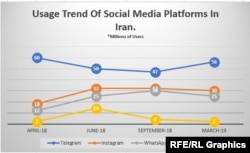One year after popular messaging service Telegram was banned in Iran in the aftermath of early 2018 mass protests, social media users have been returning to the popular platform.
The government suspected that Telegram, and social media in general, were used to mobilize crowds and organize protests in late 2017 and early 2018 in over 100 Iranian cities.
When the ban went into effect, most government agencies and a few million users dropped Telegram and authorities tried to market domestic messaging apps that they could control.
But after a year, now top government agencies including the national state-run TV and the Iranian Presidency's press office have quietly have returned to Telegram.
One reason was Telegram's effectiveness in disseminating information during devastating floods that his Iran in March and April.
The change took place in spite of hardliners' attempt to push the people toward state-controlled homegrown messaging services.
Iranian official news agency IRNA reported the online migration on Sunday April 7 with revealing infographics and a self-explanatory headline: "People Return to Telegram."
However, users resort to Virtual Private Networks (VPN) to circumvent the state blockage of the app.
In a caption underneath an infographic that shows renewed Iranian activity on Telegram, IRNA wrote: "The government was not able to prevent people's presence on Telegram."
Semi-official news agency ISNA's polling service ISPA also offered a series of facts and figures about the migration back to Telegram, observing that "In March 2018 some 60 percent of Iranians used Telegram, but the figure dropped to 56 percent in March 2019," although the the drop was not significant after the one-year ban.
An ISPA infographic shows that during the past year and while Telegram was officially banned, it was still more popular than other platforms including Instagram, WhatsApp and the homegrown messaging service Soroush.
This comes while Instagram was not banned, WhatsApp was only partially limited and Soroush offered many incentives to lure Iranian social media users.
Discussing the statistics released by ISPA, some among Iranian media outlets ask if the ban was ineffective then why Telegram is still being filtered, and why so much money has been spent on the ineffective and unpopular homegrown messaging services.
The return of Iranian state TV's news agency to Telegram is one of the strangest comebacks to the platform, as it was the state TV that sponsored the development of the homegrown platform Soroush.
Shahrvand newspaper on April 8 questiones the decisions made by the state TV to effectively abandon the messaging service it has invested on.
Shahrvand wrote that the investment should have been made on educating people and promoting media literacy.
In the meantime, it appears that Telegram has been more successful than official media in reporting the news of recent floods in Iran. News dissemination on the events surrounding the floods was done mainly on banned social media and social networking platforms.
Pro-reform news website Fararu wrote: "When Lorestan province was flooded, there was no news of the event on the state TV which has bureaus and correspondents all over Iran." Fararu, further criticized Iran's state TV for failing to report on the floods in Pol-e-Dokhtar, Mamoulan and elsewhere and instead broadcast exaggerated accounts of official measures.
Meanwhile, the Rouhani administration-owned newspaper Iran wrote that it was strange to see that even top state officials turned to banned social media in order to convey their messages effectively.
Nevertheless, Shahrvand wrote that it is unlikely to see the Iranian Judiciary taking back its May 2018 ban on Telegram.
Even in flood-hit areas people who had a chance to connect to the Internet, had to use VPNs in order to use social media for messaging and news dissemination or for calling for help. The situation led reformist MP Mahmoud Sadeqi to call for even a temporary lifting of the ban on Telegram to facilitate relief work.
International institutions and human rights watchdogs have pronounced censorship and filtering of social media tantamount to "violation of basic human rights such as freedom of expression."
Some of Iran's high-ranking officials have said that the policy of filtering and censorship during the past four decades is a failed policy. President Hassan Rouhani said in this regard in February: "We have to admit that this was a mistake."








